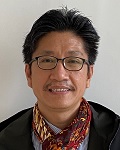Prof. Guolong Lai

Internationales Kolleg für Geisteswissenschaftliche Forschung "Schicksal, Freiheit und Prognose. Bewältigungsstrategien in Ostasien und Europa"
- E-Mail: guolong.lai@gmail.com
Associate Professor, School of Art and Art History (University of Florida)
IKGF Visiting Fellow October 2020 – June 2021
IKGF Research Project:
Continuity and Change in the Prognostic Techniques from the Shang to the Warring States Period.
Curriculum Vitae
Dr. Guolong Lai is Associate Professor of Chinese Art and Archaeology at the University of Florida. He received his BA in International Law at Jilin University, MA in Archaeology and Paleography at Beijing University, and PhD in Art History at UCLA. He has worked at the National Museum of Chinese History (now the National Museum of China), the Getty Conservation Institute, received a Pre-doctoral and Post-doctoral Fellowships from the Smithsonian Institution, the Society of Fellows in the Humanities at Columbia University, Stanford University, the American Council of Learned Society (ACLS), the Ford Foundation, the Mellon Foundation, Chiang Ching-Kou Foundation, and the Henry Luce Foundation. He was a member of the Institute for Advance Study, Princeton (2014-2015), and a Getty Scholar at the Getty Reserach Institute (2018-2019). His research interests include early Chinese art and archaeology, paleography and Old Chinese phonology, excavated manuscripts, collecting history and provenance studies, and the history of heritage conservation in modern China. He is the author of Excavating the Afterlife: The Archaeology of Early Chinese Religion (Seattle: The University of Washington Press, 2015; won the Society for American Archaeology Honorable Mention-Book Award in the Scholarly Category, 2016). He has organized conferences and workshops on various topics related to Chinese art and archaeology both in China and in the US. He has co-edited Collectors, Collections, and Collecting Arts of China: Histories and Challenges (2014), Unmasking Ideology in Imperial and Colonial Archeology (2018), and New Philology and the Study of Early China (in Chinese, 2018). He is the associate editor of the Chinese/English bilingual The Zhejiang University Journal of Art and Archaeology and The Bulletin of the Jao Tsung-I Academy of Sinology (Hong Kong).
Selected Publications
Books
- Excavating the Afterlife: The Archaeology of Early Chinese Religion. Seattle: University of Washington Press (March 2015).
Bookds edited
- Xin Yuwenxue yu Zaoqi Zhongguo Yanjiu (New Philology and the Studies of Early China), Shanghai: Shanghai renmin chubanshe, 2018 (with Jia Jinhua, Chen Wei, and Wang Xiaolin)
- Unmasking Ideology in Imperial and Colonial Archeology: Vocabulary, Symbols, and Legacy. Los Angeles: The Cotsen Institute of Archaeology Press, 2018 (with Bonnie Effros).
- Manuscript Culture in Early China,â Guest-editor for a special issue of the Chinese Studies in History, 50.3 (2017).
- Collectors, Collections, and Collecting Arts of China: Histories and Challenges. Gainesville, FL: The University Press of Florida, 2014 (co-editor and contributing author).
Articles
- "Early Chinese Screens from Archaeological Contexts," in Foong Ping and Chelsea Foxwell eds. The Multivalent Screen: Materiality and Representation in East Asian Visual Culture. Art Media Resources, 2019, 37-38.
- "Digging up China: Imperialism, Nationalism, and Regionalism in the Yinxu Excavation, 1928-1937." In Bonnie Effros and Guolong Lai eds. Unmasking Ideology in Imperial and Colonial Archeology. Los Angeles: The Cotsen Institute of Archaeology Press, 2018, pp. 83-119.
- "Loan Characters, New Philology, and the Study of Excavated Manuscripts from Early China" (in Chinese). In Jia Jinhua, Chen Wei, Wang Xiaolin, and Guolong Lai eds. Xin yuwenxue yu zaoqi Zhongguo yanjiu (New Philology and the Study of Early China), Shanghai: Shanghai renmin chubanshe, 2018.
- "On the Original Meaning of 'Shendu'" (in Chinese), The Bulletin of Jao Tsung-I Academy of Sinology, 5 (2018), 27-46.
- "Editor's Introduction," Manuscript Culture in Early China a special issue of the Chinese Studies in History, 50.3 (2017).
- "Textual Fluidity and Fixity in Early Chinese Manuscript," an English translation of Lai 2007, Chinese Studies in History 50.3 (2017).
- "The Characters 'Tu' (Rabbit) and 'Shu' (Rat) in Chu Manuscripts: Linguistic Substratum in Warring States Chu" (in Chinese). In Haeree Park and Chen Shaoxuan eds. Guwenzi yu hanyu lishi bijiao yinyunxue (Chinese Paleography and Historical Comparative Linguistics). Shanghai: Fudan University Press, 2017, pp. 179-192.
- "Continued Examination on the Diagram of the Mourning System from Mawangdui" (in Chinese) Festschrift for Professor Gao Ming on His Ninetieth Birthday. Beijing: Kexue chubanshe, 2016, pp. 262-274.
- "Addendum to the Decipherment of the Character Jie: With a Discussion of the Fallacy of the 'Conversion' of Neighboring Rhyme Groups in Load Characters and the Origin and Original Meaning of the Adverb 'Congrong'" (in Chinese), The Bulletin of Jao Tsung-I Academy of Sinology, 3 (2016), 17-45.
- "Genealogical Statements on Ritual Bronzes of the Spring and Autumn Period." In Edward Shaughnessy ed., Imprints of Kinship: Studies of Recently Discovered Bronze Inscriptions from Ancient China. Hong Kong: The Chinese University of Hong Kong Press, 2016, pp. 235-259.
- "The Emergence of 'Cultural Heritage' in Modern China: A Historical and Legal Perspective." In Akira Matsuda and Luisa Mengoni (eds.) Reconsidering Cultural Heritage in East Asia. London: Ubiquity Press, 2016, pp. 47â85.
- "Damnatio Memoriae in the Spring and Autumn Period Bronze Inscriptions" (in Chinese). In Zhu Yuanqing and Wang Tao eds. Wenben-Tuxiang-Jiyi (Text-Image-Memory). Shanghai: Huadong Normal University Press, 2015, pp. 29-44.
- "Color and Color Symbolism in Early Chinese Ritual Art: Red and Black and the Formation of the Five Colors System." In Mary M. Dusenbury ed., Color in Ancient and Medieval East Asia. Yale University Press in association with Spencer Museum of Art, University of Kansas, 2015, pp. 25-43.


